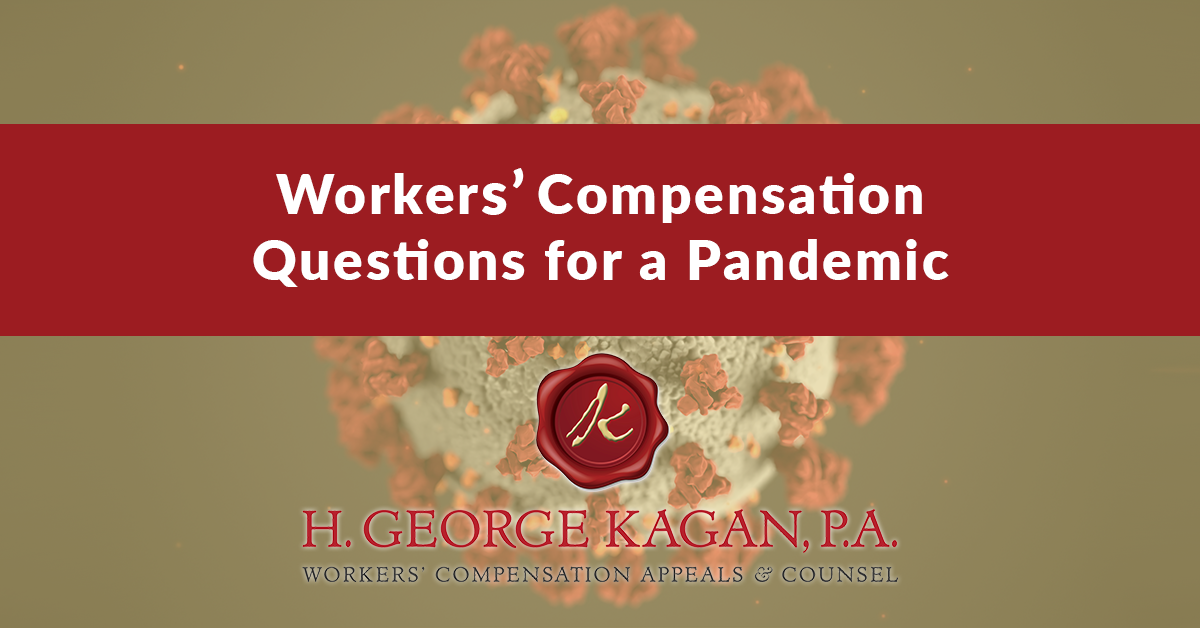
Because the pandemic is unprecedented in modern times and has generated such alarm, tragedy and massive workforce and business disruption (the extent of which remains to be seen at this writing, 3/24/20), extraneous influences such as federal and state actions and edicts may provide certain reliefs, but also: press coverage, public relations and humanitarian concerns may introduce additional stressors on industry – – all of which are outside the scope of the following projections.
To facilitate quick and easily understood access, the popular question-and-answer format will be used. (Cases noted with a * are ones with which the undersigned is personally familiar.)
Q. What part of the WC law governs the kinds of pandemic cases most likely to be encountered?
A. As discussed below there are two relevant WC sections (and one dealing with presumptions favoring first responders, Section §112.18, which is not discussed herein). While the “occupational disease” section of the statute, §440.151 “sounds” like it would apply, the one most likely to apply in most cases here is a 2003 addition to §440.02(1);
- The 2003 measure is highly restrictive; many claimant’s attorneys have given up trying to prove relevant cases under it, nevertheless for our purposes: a compensable claim requires clear and convincing documentation of exposure to the virus, which often is impossible to show or prove absent a well-documented case of contact with known carrier. (But see ‘special note’ regarding availability of proof near conclusion.)
- An example of the difficulties is found in a recent death case, Sch. Dist. of Indian River County v. Cruce, 289 So. 3d 36 (Fla. 1st DCA 2019) and its ‘clear and convincing’ evidence discussion in which the court noted;
- “..section 440.02(1) now focuses on a “dose-response” relationship requiring: 1) proof of actual exposure (ingestion or absorption); 2) the levels to which one is exposed (dose); and 3) that such levels are capable of causing injury or disability.
***
“But, the JCC reasoned that to require quantitative testing for a “ubiquitous” fungus would create an impossible burden because the employee could not know exactly when the exposure to the fungus occurred. The JCC further noted that by the time litigation was initiated in this case, Claimant could not perform testing because the stadium had been destroyed. He concluded that, even if the worksite had not been destroyed, any measurement for the fungus was essentially meaningless unless performed at the time of the exposure. This interpretation is in derogation of the requirements of section 440.02(1).” ****“Expert testimony that cryptococcus fungus is ubiquitous does not alone constitute clear and convincing evidence sufficient to satisfy the burden of proving workplace presence. This Court has previously condemned broad assumptions and speculation in this context. *** The initial burden of proving the existence and levels of toxic substances at the workplace lies with the employee.”
- “..section 440.02(1) now focuses on a “dose-response” relationship requiring: 1) proof of actual exposure (ingestion or absorption); 2) the levels to which one is exposed (dose); and 3) that such levels are capable of causing injury or disability.
- To underscore the above message -- but also possible problems/vulnerabilities with it – – a case followed immediately after, having quite a similar theme
- “In reaching this decision, we readily acknowledge the Herculean task created by the heightened burden of proof for toxic exposure claims. However, in deference to the Legislature we will not craft, in derogation of the plain text of sections 440.02(1) and 440.09(1), a lesser burden of proof.“ City of Titusville v. Taylor, 288 So. 3d 731, 737 (Fla. 1st DCA 2019)
Judge Wolf reluctantly concurred with the majority opinion, writing in effect that if that were the law;
“I am, therefore, not convinced that workers' compensation is a viable alternative to the tort system for workers that are injured by toxic exposure at the work place. Either the court system or the Legislature must deal with this problem.”
- “In reaching this decision, we readily acknowledge the Herculean task created by the heightened burden of proof for toxic exposure claims. However, in deference to the Legislature we will not craft, in derogation of the plain text of sections 440.02(1) and 440.09(1), a lesser burden of proof.“ City of Titusville v. Taylor, 288 So. 3d 731, 737 (Fla. 1st DCA 2019)
- Now we have what may be described as the perfect storm, hence the projection that in this pandemic, there may be pressure on the court to relax the contours of this provision.
- Then again maybe not, as we are now well into a more doctrinaire era.
“A claimant either meets the requirements for coverage under section 440.151, or he does not. This court has previously refused to incorporate other subsections of the Act to add to or supplement the clearly delineated requirements set forth in section 440.151.” City of Port Orange v. Sedacca, 953 So. 2d 727, 729 (Fla. 1st DCA 2007)
- The “occupational disease” path has likewise not been easy even where front-line health care workers contract illnesses seemingly more likely to arise out of work than in other occupations. For example, in a case suggesting how pandemic claims might unfold, an employee who installed and occasionally cleaned medical equipment for homebound patients was diagnosed with fulminant meningococcemia (a virulent and often fatal form of meningitis, and was hospitalized for several months and suffered serious physical damage). The court rejected claimant’s “logical” theory of having likely inhaled tiny droplets in connection with handling the respiratory machines where no customer was shown to have suffered from a neisseria infection -- even though many do and are immune to its effects. Glasrock Home Health Care v. Leiva*, 578 So. 2d 776 (Fla. 1st DCA 1991).
- See also City of Tamarac v. Varellan*, 463 So. 2d 479, 480 (Fla. 1st DCA 1985); police trainee swimming in algae laden pool failed to connect same with his hepatitis-B virus;
- D'Avila, Inc. v. Mesa*, 381 So. 2d 1172, 1172 (Fla. 1st DCA 1980)(aggravation of asthma alleged to result from fine particulate matter in the workplace air, not sufficiently proven, albeit under ‘accident’ (not occupational disease) theory of recovery)
A. Although this question may be moot given imminent widespread public testing regardless of employment, nevertheless, responsibility on employers for providing medical tests has generally required a showing of some documented (versus more general, possible) exposure. Tests are much easier to obtain in the context of an already compensable case, i.e., even where they are not readily associated with injury, so long as there is a reasonable basis for suspicion of a connection (in other words MCC not necessary in order to claim testing in an already compensable claim).
- Two cases form the “bookends” here.
- Not compensable: a claim for medical monitoring following mere exposure to asbestos: some injury (or occupational disease) must be shown before medical benefits may be awarded. Florida Power Corp. v. Brown, 863 So. 2d 364 (Fla. 1st DCA 2003)
- Compensable: work exposure to beryllium led to some detectable physiological changes, requiring only that claimant refrain from further contact and have periodic medical monitoring. The court ruled: while “mere exposure, standing alone, will not suffice,” here the “verifiable change in his body that requires medical treatment” satisfied test for compensable exposure.
Huff v. Loral Am. Beryllium Co., 967 So. 2d 244 (Fla. 1st DCA 2007)
- Caution: to reiterate, given ubiquity of contaminated individuals, air, and surfaces of the pandemic vis-à-vis the difficulty in proving up details regarding one inadvertent touch or breath leading to eye contact, etc., this is an area most likely to be challenged, i.e. it is possible the court will relax the burden of proof regarding specific exposure given general prevalence and concern. But: a countervailing argument is: such exposures may not be different from those faced by the general public, which has always been a bar to such claims unless a unique and persuasive “arising out of” demonstration is made
A
. Again it is important to distinguish between merely flu-like symptoms and even a documented exposure, i.e. a contact which may – or may not – produce infection -- and actual contraction/infection.- Suspicion: Florida law does permit a claim for testing in the case of a documented or strongly suspected (with good cause) exposure, and if the test result is negative, that is the end of entitlement. It is frankly good public policy to facilitate rather than hinder such tests.
- Infection/contraction linked -- by satisfying a worker’s burden of proof -- to a specific workplace exposure opens the door a compensable claim for all benefits (including treatment, temporary disability and death, discussed below).
- Nevertheless: an individual worker’s burden of proof presently remains difficult to satisfy.
- Caution: in light of the above the court may feel pressured, given the pandemic, to extend a doctrine enunciated in
Monette v. Manatee Mem'l Hosp., 579 So. 2d 195, 197 (Fla. 1st DCA 1991). There the claimant had an allergic reaction to a flu shot administered in her hospital for same reason anybody would have a flu shot, except, as the court noted, as a nurse in a hospital she was employed in a “high risk category,” and so because the protection was both for herself and for her patients, the court ruled her allergic reaction “flowed as a natural consequence of her employment.” - Alternatively, the pandemic may give cause for the court to ‘reset’ certain employments, given widespread exposure and concern, so as to enable them to qualify as appropriate for occupational disease claims, a designation which eases the burden of proof in a specific case where an industry or occupation itself enhances prospects of exposure/contraction.
A.
Yes to all the above.- A leading case is Suniland Toys and Juvenile Furniture, Inc. v. Karns, 148 So.2d 523 (Fla.1963). Claimant, exposed to possibly contaminated water following hurricane, accepted employer’s invitation to voluntarily avail herself of vaccination offered by lessor of afflicted shopping center and suffered allergic reaction to inoculation. The court ruled claimant’s “freedom” to choose whether or not to be inoculated did not negate fact her injury “originated in some risk connected with the employment or flowing as a natural consequence from the employment.” The Suniland case was followed in the above cited Monette v. Manatee Mem'l Hosp., 579 So. 2d 195, 196 (Fla. 1st DCA 1991)
- Parenthetically, because the employer is liable without control over negligent medical care, an interesting series of cases in which the undersigned was involved established a lien in the employer’s behalf on third-party recoveries following medical malpractice: details available on request.
A.
Becoming symptomatic at work is not and has never been a basis for an injury claim. Risks personal to the claimant which are effectively “imported” to the workplace do not arise out of employment. This has applied to ‘heart attacks,’ seizures, jealous lovers (without employment facilitation) and in a unique case, injury while attempting to retrieve personal property from a rolling car being repossessed from the employer’s lot. Sentry Ins. Co. v. Hamlin, 69 So. 3d 1065 (Fla. 1st DCA 2011)- The leading case in this area is probably Leon County Sch. Bd. v. Grimes*, 548 So.2d 205 (Fla.1989), wherein the Supreme Court held:
“The purpose of the act is to shoulder on industry the expense incident to the hazards of industry; to lift from the public the burden to support those incapacitated by industry and to ultimately pass on to the consumers of the products of industry such expense. Our act affords no relief for disease or physical ailment not produced by industry. *** Further, we have explained that chapter 440 “was not designed to take the place of general health and accident insurance.”
A.
A recent en banc (all judges) opinion of the First District Court of Appeal greatly influences the outcome in such circumstances; the notorious adjuster who “tripped over the dog while getting coffee” case, Sedgwick CMS v. Valcourt-Williams, 271 So. 3d 1133 (Fla. 1st DCA 2019).- Though it will be a challenge to get the mix just right in this pandemic, in keeping with the “repo” case discussed above (Hamlin); if the risk was “imported into the work place” which is to say, personal to the family home or employee, and not in any meaningful way connected with work duties or work machines, then contraction will likely not be compensable.
- Under this analysis exposure from a family member would not support a claim but again, we are dealing with unique circumstances even in the home environment which may prompt the court to be more liberal on risks there. Remember that in Williams, claimant’s reaching for a cup of coffee was perfectly in keeping with the course and scope of home employment: only the intercession of the family dog claimant tripped over was deemed to be the interjection of a personal, nonemployment risk of harm that actually led to the injury. There is no longer any such thing as a compensable “workplace trip-and-fall” unless there is occupational causation. As the court put it in Williams;
“But the question is not whether a claimant's “home environment” becomes her “work environment”; the question is whether the employment — wherever it is — “necessarily exposes a claimant to conditions which substantially contribute to the risk of injury. **** Here, the relevant risk was that the claimant might trip over her dog while reaching for a coffee cup in her kitchen. That risk exists whether the claimant is at home working or whether she is at home not working. It existed before Valcourt-Williams took her job, and it will exist after her employment ends (so long as she maintains a home with a dog). Because the risk did not arise out of the employment, we must reverse.”
- As such, the relevant inquiry will be: did a work or personal life vector directly cause/facilitate contraction of the disease?
- A clear example: contracting the disease from a visiting relative would almost certainly not be compensable.
- Conversely, contracting the disease from a vendor installing, repairing or merely delivering work materials or equimpment would almost certainly be compensable.
- An important public policy consideration driving the undersigned's response to the first example (visiting relative) is the fact that now, in most "new" cases of at-home employment, the work environment is not seen as a direct benefit to the employer but rather to society at large, to thwart the spread of the pandemic.
- The same will be true for medical providers, who have stringent requirements for treatment vis-à-vis reporting and billing in an emergency, but if they satisfy these, the employer will be expected to pay/reimburse for treatment rendered in compensable cases.
- CAUTION: In settlements, be mindful of federal liens, etc.
- However: a psychological reaction to perceived but non-existent poisoning (claimant was standing in liquid thought to be a toxic substance, but which turned out not to be) are not compensable. Symptoms resulting from fear and excitement of exposure without injury are not compensable. Polk Nursery Co., Inc. v. Riley, 433 So. 2d 1233 (Fla. 1st DCA 1983) We may see a lot of this.
- In mild “confirmed” cases there will only be medical monitoring, possible temporary benefits during mandatory isolation (if work cannot be accomplished at home), costs of whatever drugs are made available, and so on.
- In more serious cases, medical costs may be intense (respiratory, ICU), but likely for briefer durations than in other serious illness/injury cases.
- Death benefits would apply where appropriate.
- Normal statute of limitations would apply (with its special provision regarding death benefits if applicable).
A.
I would analogize this with cases wherein a claimant declines an invasive medical procedure designed to reduce disability based on reasonable fears: these cases are judged on their unique circumstances (some dealing with prior experiences the claimant may have had, or those family members may have had) -- but going out on a limb I would say such fear here would be deemed reasonable, i.e., there is a reasonable perception of the life or death risk. Notwithstanding this projection, if the physician's office represents that it has taken all due cautions, spacing out visits, etc. the court might not compel continuing benefits under the circumstances.However, if the doctor's offices are closed to all but emergency cases, then I think the decision goes to the claimant given the last documentation is TTD or TPD and cannot be revisited through no fault of the claimant. The duration of the situation probably could not go more than a couple of months during this acute phase of the pandemic.
Special Note: This could be a breakthrough moment for tele-medicine. Claims should work with physicians’ offices to set up exactly this kind of protocol. The answer is not perfect, in that the clinical setting cannot be replicated with exactitude, but this process should be able to address claims at the tail end of disability. If a physician declines -- while declining to see non-emergency cases -- this can be construed as a refusal to treat, warranting employer selection of an alternate treating physician. This may not go smoothly if challenged by the claimant but it offers a way to process the claim with forward momentum with reasonable foundation in fact.
Q. Are there other WC doctrines likely to be impacted?
A. It is possible we will see more “borrowed servant” and emergency volunteer cases. There is little risk of this occurring in large numbers but an uptick over the norm can be expected.
Conclusion. Some external forces mentioned at the outset may place unprecedented pressures on the courts, carrying the potential to create excess and possibly unreserved burdens on Florida businesses large and small. Patience, empathy, compassion and generosity are all laudable and appropriate, but to borrow from the announcement heard at the outset of every airline flight: when traveling with small children, the parent must be assured of oxygen first, before he or she can be of any use to an infant.
In other words: it is suggested the overarching imperative is: while industry should shoulder all authentic obligations, it should not become more depleted by novel, additional burdens which may jeopardize recovery as we emerge from this ordeal (it seems obvious even now many good businesses will not survive). That is why it is hoped the courts will cleave largely to the above described precedent, and not for example, greatly liberalize evidentiary ‘exposure’ burdens, so as to help preserve the integrity of a WC structure that can help facilitate recovery, jobs, and job re-creation when the Florida sun again shines on healthy throngs of workers and vacationers. To borrow from an especially tragic Florida case; sympathy cannot become a substitute for liability;
“It is clear from the record that the claimant, who has since died, presented a compelling portrait for sympathy, and the medical expense for treating ALS is staggering. Visiting this expense on the employer must be supported by evidence which is both competent and substantial.” Above All Drywall v. Shearer*, 651 So. 2d 195, 197 (Fla. 1st DCA 1995)


